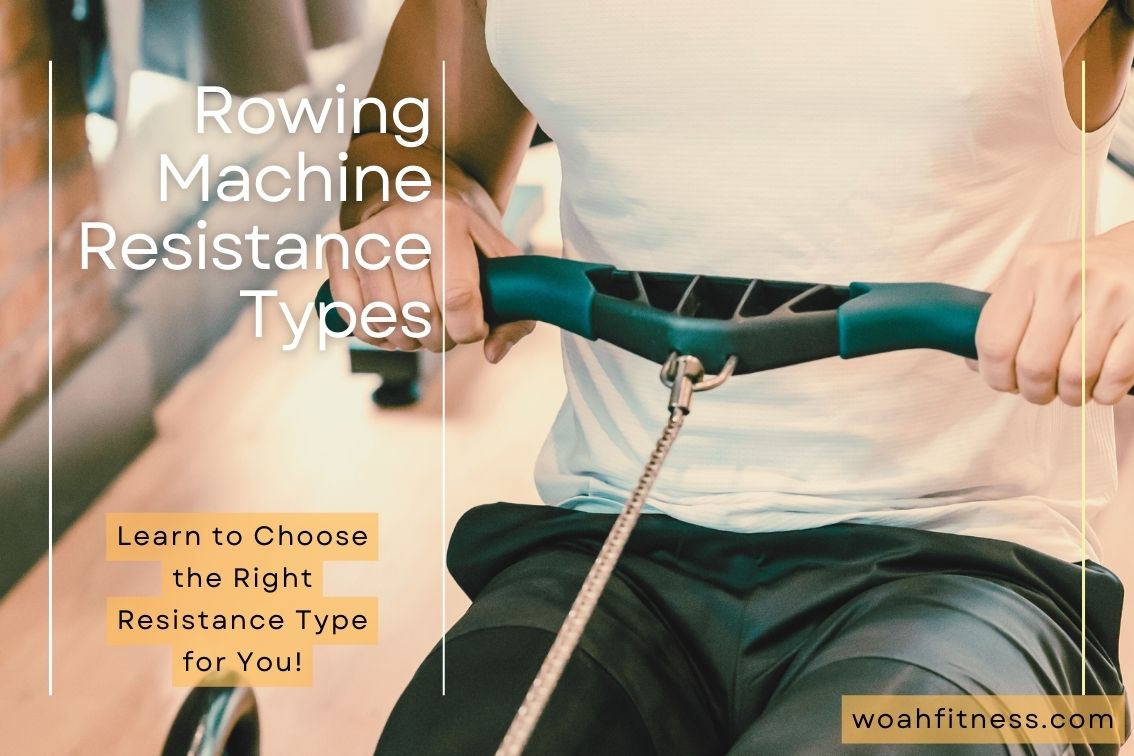Choosing the Right Resistance Type for Your Rowing Machine

Table of Contents
In this article
As a coach who helps people reach their fitness goals, I know that rowing machines are one of the most effective full-body workout tools, regardless of fitness level. It doesn’t matter where you fall on the fitness spectrum. A rowing machine will give you an amazing workout that includes cardio and strength.
But before you decide to buy the first rower that catches your eye, let’s take the time to understand one of its most important aspects: how it provides resistance.
In this article, I touch on the four types of resistance in rowing machines: air, magnetic, hydraulic, and water. Together, we will delve into the unique features of each type to help you choose the best possibility for your workout. We’ll explore how each works, their pros and cons, and who they’re best suited for. Whether you’re looking to amp up your fitness regime or just starting out, I want to make sure you have all the information you need to make the right choice. Let’s get started!
Understanding Resistance in Rowing Machines
Resistance is the force against which your muscles work. It’s what makes the workout challenging and, as a result, effective. Proper resistance can enhance your workout and ensure that you exercise safely.
When it comes to rowing machines, resistance is what you feel in your arms and core as you pull back on the handle and in your legs when you slide back and forth. It simulates the feeling of oars moving through water.
It’s this resistance that makes the workout challenging. It pushes your muscles to work harder, which leads to stronger, leaner muscles. It also gets your blood flowing, which improves your cardiovascular fitness. Though all rowers will provide these benefits to some degree, the differences in how they work will affect how you work out.
Rowing machines offer four types of resistance: air, magnetic, hydraulic, and water. Each type works differently and provides a unique set of benefits and drawbacks. Your choice of resistance will ultimately depend on your fitness goals, budget, and personal preference. Let’s take a closer look at each type.
Air Resistance
Air resistance rowing machines are the most used and recommended by rowing teams. They run using a flywheel that spins when you pull the handle. The spinning flywheel pushes against the air like a fan, creating resistance. The harder and faster you row, the more resistance you’ll feel.
The main advantages of air resistance rowers are their smooth, natural rowing motion and variable resistance. Resistance is automatically adjusted based on your rowing speed. In other words, if you put in some effort, you will get a challenging workout. It doesn’t matter how fit you are.
But they do come with a couple of drawbacks. I find that air resistance machines tend to be quite noisy since the spinning flywheel creates wind noise. They are also usually larger and take up more space than other types.
Scenario: Joe, the Competitive Athlete
Profile: Competitive athlete, spacious home gym, no noise concerns, diligent with maintenance.
Benefits of Air Rower:
- Responsive Resistance: Adjusts resistance with rowing speed, mimicking real water rowing.
- Intensity: Provides high-intensity workouts suitable for rigorous training.
- Technique: Smooth motion aids in practicing proper technique.
Scenario: Remi’s Apartment Living
Profile: Lives in a small apartment, values quiet workouts, limited space, prefers low maintenance.
Drawbacks of Air Rower:
- Noise: Loud during high-intensity workouts, potentially disturbing neighbors.
- Space: She requires more room than is available in her apartment.
- Maintenance: Needs regular cleaning, which can be inconvenient.
Alternative for Sarah:
Magnetic Resistance Rower: Quiet, compact, low-maintenance, better suited for apartment living.
Magnetic Resistance
Magnetic resistance rowing machines run using a magnetic brake system. The resistance is adjusted by moving the magnet closer or farther from the flywheel. Unlike air resistance, the resistance level in magnetic rowers is set by hand, regardless of your rowing speed.
One key advantage of rowing machines with magnetic resistance is their quiet operation. They are virtually silent, making them an excellent option for home use, especially if you live with others or share walls with neighbors. They also typically have a smaller footprint, making them a good choice for smaller spaces.
But, the rowing motion on magnetic rowing machines may not feel realistic since the resistance doesn’t change with your rowing speed.
Scenario: Emily, the Busy Professional
Profile: Busy professional, lives with family, prefers quiet workouts, limited time for maintenance, moderate space available.
Benefits of Magnetic Rower:
- Quiet Operation: Magnetic rowers are virtually silent, making them ideal for early morning or late-night workouts without disturbing family members.
- Consistent Resistance: Provides a smooth and steady resistance, making it easy to control and adjust for various workout intensities.
- Low Maintenance: Requires minimal upkeep, which is perfect for someone with a busy schedule and limited time for equipment maintenance.
Scenario: Mark, the Outdoor Enthusiast
Profile: Outdoor enthusiast, enjoys high-intensity workouts, has a spacious home gym, prefers realistic rowing experience.
Drawbacks of Magnetic Rower:
- Lack of Dynamic Resistance: Unlike air or water rowers, magnetic rowers do not adjust resistance based on rowing speed, which can make high-intensity training less challenging.
- Less Realistic Feel: The rowing motion may not feel as natural or dynamic, which might not satisfy someone looking for an experience similar to outdoor rowing.
- Intensity: May not provide the same high-intensity workout that Mark is accustomed to.
Alternative for Mark:
Air Resistance Rower: Offers responsive resistance that increases with speed, providing a more challenging and realistic rowing experience suitable for high-intensity training.
Hydraulic Resistance
Hydraulic resistance rowing machines use cylinders filled with fluid to create resistance. As you ow, you push against the fluid in the cylinders. The resistance is adjusted by hand by changing the amount of fluid in the cylinders.
Hydraulic rowers are typically the most affordable type of rowing machine. They are usually compact and lightweight, making them a good choice for those with limited space or budget.
However, the rowing motion on hydraulic machines can be less natural than on other types, and they may need more maintenance as the fluid in the cylinders may need to be replaced over time.
Scenario: Jane, the Budget-Conscious Beginner
Profile: Fitness beginner, limited budget, small home gym, seeks a compact and affordable rowing machine.
Benefits of Hydraulic Rower:
- Affordability: Typically the most cost-effective type of rowing machine, making it a great choice for beginners or those on a tight budget.
- Compact Size: Hydraulic rowers are often smaller and can be easily stored, perfect for small spaces or home gyms with limited room.
- Adjustable Resistance: Allows for manual adjustment of resistance, enabling a customizable workout at different intensity levels.
Scenario: Mike, the Serious Athlete
Profile: Serious athlete, large home gym, prefers high-intensity, dynamic workouts, values a realistic rowing experience.
Drawbacks of Hydraulic Rower:
- Less Realistic Motion: The rowing motion on hydraulic rowers may not feel as natural or smooth, which can be a drawback for those seeking an authentic rowing experience.
- Limited High-Intensity Training: Hydraulic rowers may not provide the same level of high-intensity resistance that serious athletes require for rigorous training.
- Maintenance: Hydraulic cylinders may require more maintenance and occasional fluid replacement, which can be inconvenient for someone focused on intense training.
Alternative for Mike:
Air Resistance Rower: Offers a dynamic and responsive resistance that increases with speed, providing a more realistic and challenging rowing experience suited for high-intensity workouts and serious training.
Water Resistance
Water resistance rowing machines use a tank filled with water and a spinning paddle to create resistance. The resistance increases the harder and faster you row, like rowing a boat in actual water. It’s quite like how air resistance rowers work.
Water rowers offer a very realistic rowing experience in terms of the rowing motion. They also provide a smooth and consistent resistance throughout the stroke.
On the downside, water rowers are usually the most expensive rowing machines. They also tend to be larger and heavier than other types. Another issue is that algae can grow in the tank’s water, but using water purification tablets can fix that.
Scenario: Lisa, the Rowing Enthusiast
Profile: Rowing enthusiast, large home gym, loves the authentic rowing experience, comfortable with regular maintenance.
Benefits of Water Rower:
- Realistic Rowing Experience: Mimics the feel and sound of rowing on water, providing an authentic and enjoyable workout.
- Smooth Resistance: Offers a smooth and consistent resistance that increases with rowing intensity, ideal for practicing proper technique and endurance training.
- Engaging Workouts: The natural water sounds can make the workout more engaging and meditative.
Scenario: Tom, the City Dweller
Profile: Lives in a small apartment, prefers quiet workouts, limited space, minimal time for maintenance.
Drawbacks of Water Rower:
- Noise: The sloshing sound of water, while pleasant for some, can be disruptive in a small living space or shared apartment.
- Space: Water rowers are typically larger and heavier, requiring more space than is available in a compact apartment.
- Maintenance: Requires periodic water treatment to prevent algae growth, which might be inconvenient for someone with a busy lifestyle.
Alternative for Tom:
Magnetic Resistance Rower: Quiet, compact, and low maintenance, making it better suited for apartment living and a busy schedule.
Comparing the Resistance Types
Each type of resistance in rowing machines offers a unique rowing experience and has its own benefits and drawbacks. Choosing the right one depends on various factors, such as your fitness goals, budget, available space, and personal preference.
Air resistance rowers provide a natural and dynamic rowing experience, making them a favorite among serious rowers and fitness enthusiasts. They offer variable resistance, which increases with your rowing speed. It provides a challenging workout for all fitness levels. However, they tend to be noisier and bigger than other types.
Magnetic resistance rowers are known for their quiet operation and constant resistance, regardless of your rowing speed. They are an excellent choice for those who prefer a quieter workout or live in apartments. However, their rowing motion may not feel as realistic as air or water rowers.
Hydraulic resistance rowers are the most affordable and compact, making them suitable for those on a tight budget or with limited space. However, they may not offer a natural rowing experience and require more maintenance.
Water resistance rowers offer the most realistic rowing experience and smooth, consistent resistance. They are ideal for those who want a rowing experience close to actual rowing. However, they are usually the most expensive and require more space and maintenance.
There is no one-size-fits-all when choosing the right resistance type for your rowing machine. It’s about finding the one that best suits your unique needs and fitness goals. Whether you prefer air, magnetic, hydraulic, or water resistance, each type can provide a challenging and effective workout when used correctly.
Conclusion
Choosing the right resistance type for your rowing machine is crucial in ensuring you get the most out of your workout. It’s not just about the intensity of the exercise but also about how the machine aligns with your fitness goals, space constraints, and budget.
Remember, the best rowing machine is the one that you will use again and again. It should challenge you but also be enjoyable to use. If that’s the natural feel of an air or water rower, the quiet of a magnetic rower, or the accessibility of a hydraulic rower, the right machine is a personal decision.
Take the time to consider your options and think about what you want from your workouts. With the right resistance type, your rowing machine can provide an engaging workout to help you reach your fitness goals.
